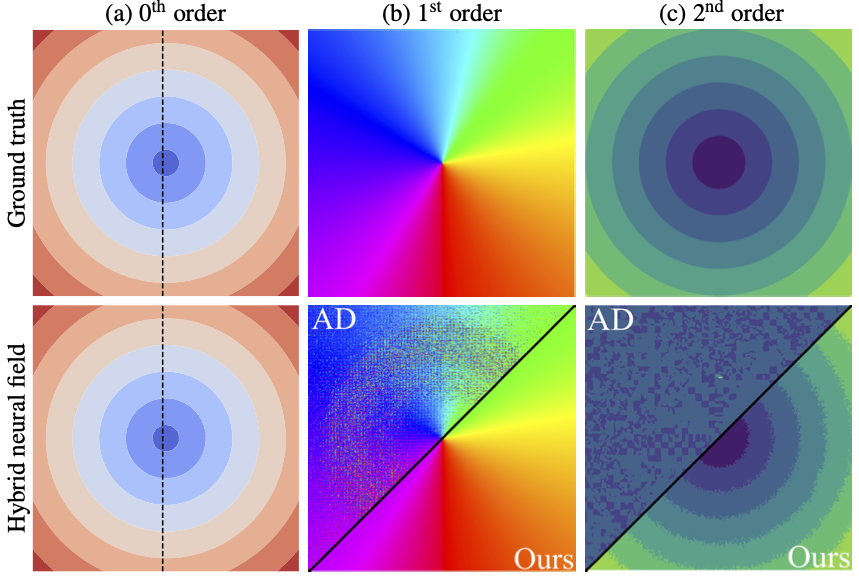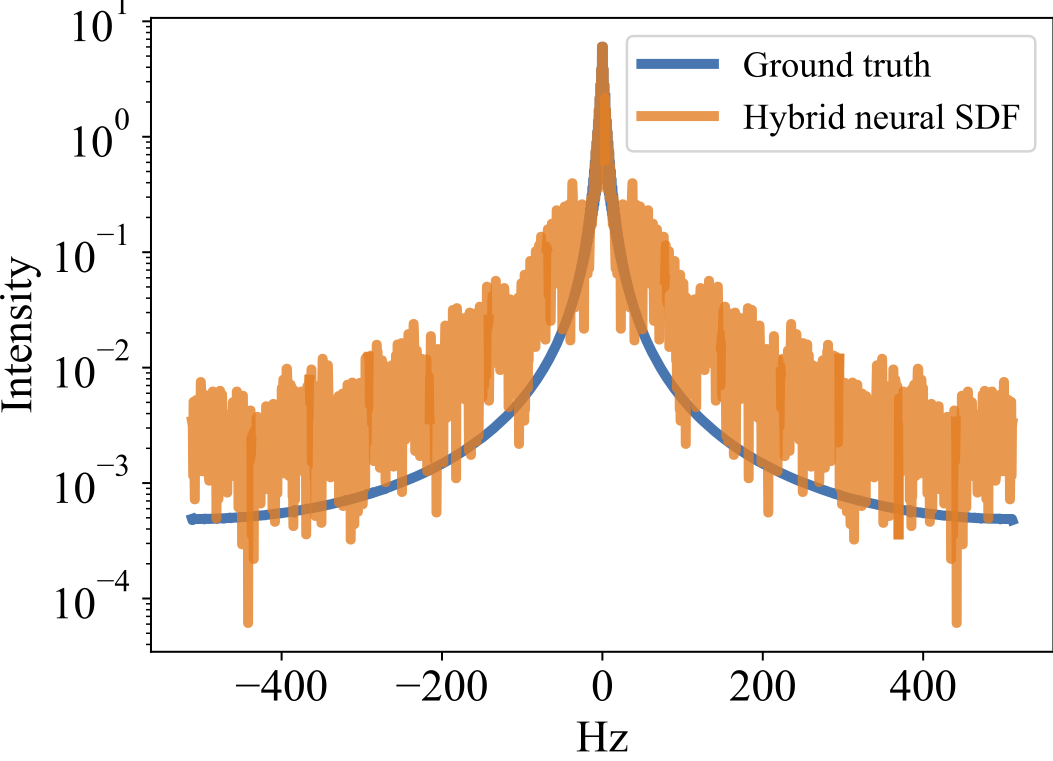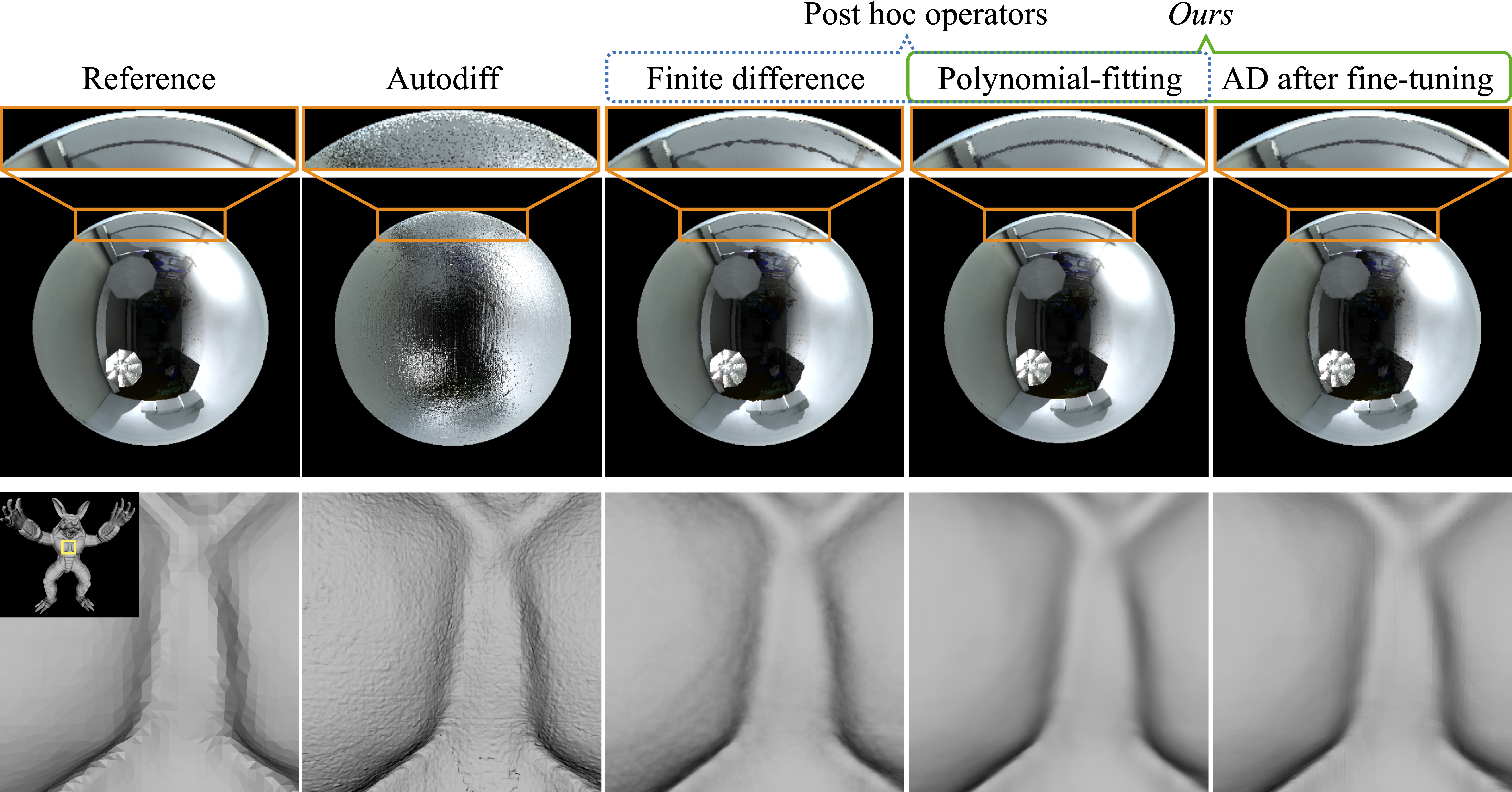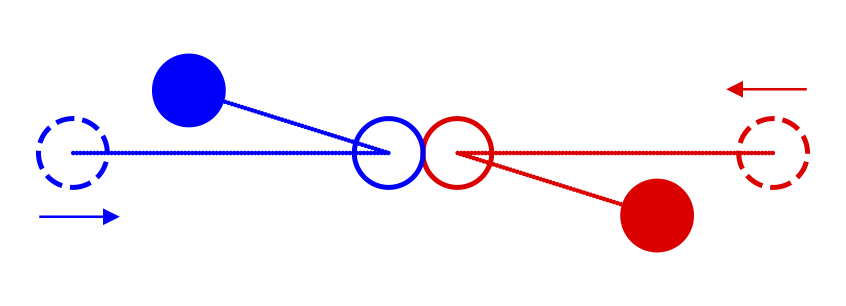High-frequency noise in hybrid neural fields
We observe that hybrid neural fields contain high-frequency noise in the learned signal. This noise can cause artifacts in derivatives computed using automatic differentiation.
These artifacts cause issues in downstream applications like rendering and solving PDEs with hybrid neural fields.
Method
We propose two approaches to alleviate this problem: post hoc polynomial-fitting operators and a fine-tuning approach to improve the accuracy of autodiff derivatives.
Post hoc polynomial-fitting derivatives
Given a pre-trained hybrid neural field and a query point, we propose fitting a polynomial through the local neighborhood of the query point. We then compute autodiff derivatives of this fitted polynomial instead of the learned signal.
Fine-tuning approach
Since our post hoc operators would require changes in the downstream pipelines. To prevent this, we also propose a fine-tuning approach that aligns the autodiff derivatives of hybrid neural fields with the smoothed derivatives from alternative sources like our post hoc operators or finite-difference stencils, while preserving the original 0th order signal. Our fine-tuning objective is independent of the type of smoothed derivative operator itself.
Results
We evaluate our methods on hybrid neural SDFs of 3D shapes from the FamousShape dataset. We experiment with tree type of hybrid neural fields: Instant NGP, Dense Grid, and Tri-plane (only post hoc analysis). Below, we show the evaluation results for Instant NGP. For detailed results, please refer to our paper.
Our post hoc operators are able to provide more accurate derivatives than finite-difference or autodiff baselines, and perform on-par, if not better than Monte Carlo approaches like gaussian averaging of autodiff derivatives.
| Method | Surface Normal | RRE ↓ | |||
|---|---|---|---|---|---|
| L2 ↓ | Ang ↓ | AA@1 ↑ | AA@2 ↑ | ||
| AD | 0.21 | 12.40 | 1.58 | 6.12 | - |
| FD | 0.07 | 4.20 | 26.86 | 55.22 | 3.67 |
| GAD | 0.05 | 2.99 | 38.35 | 66.86 | - |
| SFD | 0.95 | 57.67 | 0.01 | 0.07 | - |
| Ours | 0.05 | 2.80 | 42.92 | 67.90 | 0.89 |
Our fine-tuning approach also yields more accurate autodiff operators than directly applying autodiff, while preserving the fidelity of the original neural field. Our approach also performs better than traditional regularization approaches like Eikonal regularization that were proposed to encourage smoother iso-surfaces in neural fields.
| Method | Surface Normal | Mesh Reconstruction | ||||
|---|---|---|---|---|---|---|
| L2 ↓ | Ang ↓ | AA@1 ↑ | AA@2 ↑ | Chamfer Distance ↓ | F-Score ↑ | |
| - | 0.21 | 12.40 | 1.58 | 6.12 | 9.24 × 10-4 | 93.07 |
| Eikonal | 0.11 | 6.51 | 12.24 | 31.48 | 9.23 × 10-4 | 92.90 |
| FD-Eikonal | 0.10 | 6.17 | 13.71 | 33.27 | 9.25 × 10-4 | 89.85 |
| FD | 0.08 | 5.14 | 21.16 | 46.63 | 9.35 × 10-4 | 90.24 |
| Ours | 0.05 | 3.19 | 33.60 | 60.24 | 9.28 × 10-4 | 92.28 |
Applications
Our approaches also provide advantages in downstream applications of hybrid neural fields.
Rendering
Rendering hybrid neural SDFs with our approaches yields results that are free from unnecessary artifacts that arise in the case of directly using of autodiff derivatives.
Collision simulation
Surface normals are required for accurate simulations when modeling collisions to compute trajectories. We consider the case of two spheres undergoing head-on collisions and simulate their trajectories post-collision. To obtain these trajectories, we use the normal estimates from the two SDFs at the analytical point of contact.
We model the collisions as perfectly elastic so that there is no loss of energy. In the ideal case, the spheres should rebound along the line joining the centers with the same velocity, but erroneous normal estimates will lead to incorrect trajectories.
Averaged over 106 trials, the mean error obtained from our normals was 0.85°, compared to 11.51° for autodiff normals.
Solving PDEs
We show that using our operators for solving a 2D advection equation using a hybrid neural field prevents the solution error from exploding. We solve an initial value problem with the gaussian pulse being advected with a constant velocity.
We plot the mean squared error (MSE) for a finite difference grid solver, autodiff gradients (AD), and our polynomial-fitting approach. The error for AD explodes after the first few seconds and eventually crashes (indicated by ×). Using the same hybrid neural field with our operator leads to more accurate solutions at all time steps.








